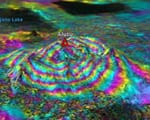The next-generation of the Super Cryogenic Dark Matter Search, called SuperCDMS, is slated for construction at SNOLAB, an underground laboratory in Ontario, Canada
Dark matter makes up much of the universe, and surrounds us all like an invisible soup. Physicists have hunted dark matter particles for decades, but they continue to elude observation.
Now a major international experiment aimed at discovering dark matter could be constructed and operational by 2018, according to the consortium of scientists on the experiment known by its acronym, SuperCDMS SNOLAB.
With SuperCDMS SNOLAB, physicists will go deeper below the surface of the earth than earlier generations of the experiment. Deep underground, scientists use the earth as a shield to block out particles that resemble dark matter, making it easier to see the real thing.
Physicists have begun research and design and are building prototypes for the next-generation SuperCDMS, known by its full name as the Super Cryogenic Dark Matter Search. It will be located at SNOLAB, an existing underground science laboratory in Ontario, Canada, said physicist Jodi Cooley, a SuperCDMS scientist.
As an experimental particle physicist, Cooley heads the dark matter project team at Southern Methodist University, Dallas, and is a designated principal investigator, or lead scientist, on the SuperCDMS experiments.
Research and design of SuperCDMS SNOLAB is slated to continue through 2015, with fabrication in 2016 and 2017. The experiment could be ready for operational testing by 2018, Cooley said.
DOE and NSF announce support for SuperCDMS SNOLAB
The U.S. Department of Energy and the National Science Foundation recently announced they will fund SuperCDMS SNOLAB — as well as two other unrelated dark matter experiments — as part of a committed U.S. scientific focus on furthering investigation into elusive dark matter. The agencies previously funded the predecessors to SuperCDMS SNOLAB, known as SuperCDMS Soudan and CDMS.
“This is a very exciting time in our field, and I think the United States is well-positioned to play a key role,” said Cooley, an associate professor in SMU’s Department of Physics. “The three experiments chosen, SuperCDMS, LZ and AMDX, are complementary and together provide sensitivity to a large variety of potential dark matter candidates. In particular, SuperCDMS provides unprecedented sensitivity to light dark-matter candidates.”
SuperCDMS SNOLAB is a collaboration of physicists from 21 institutions in the United States, Canada and Europe.
Dark matter — the next unsolved mystery, and a key to the Universe
There has long been evidence that dark matter exists and is a large part of the matter that makes up the Universe. A handful of experiments around the globe, including SuperCDMS Soudan and CDMS II, use different methods to focus on the hunt for dark matter.
The design of SuperCDMS SNOLAB, which is among the world’s leading dark matter projects, enables it to look for WIMPS, short for weakly interacting massive particles.
WIMPS are a generic class of dark matter, with an unknown mass that could be either “light” or “heavy.” SuperCDMS has unprecedented sensitivity to the light mass, sometimes called low mass, WIMPS. The LZ experiment will have unprecedented sensitivity to heavy mass, or high mass, WIMPS. AMDX looks for a different type of dark matter called an axion.
CDMS and SuperCDMS Soudan also focus on lower mass dark matter.
Deep below the ground, to block out distractions
SuperCDMS SNOLAB will be constructed 6,800 feet underground — much deeper than CDMS or SuperCDMS Soudan, which are 2,341 feet below the earth in an abandoned underground iron mine near Soudan, Minn. Depth decreases what Cooley refers to as the “background noise” of other particles that can mimic dark matter or cloud an observation.
DOE and NSF announced they would fund dark matter experiments in the wake of recommendations in May from their Particle Physics Project Prioritization Panel, a task force of the DOE and NSF made up of U.S. physicists.
In its report, the panel didn’t specify any particular dark matter experiments for funding, but broadly concluded that investment in the search for dark matter is key for the United States to maintain its status as a global leader in addressing the most pressing scientific questions.
Total projected cost for SuperCDMS SNOLAB is about $30 million.
SuperCDMS: How it works
The heart of SuperCDMS is an array of 42 detectors the size of hockey pucks, stacked atop one another in a copper canister encased in a large cooling tower. Their purpose is to capture any evidence of dark matter with their silicon and germanium surfaces, which are cooled to near absolute zero to measure single particle interactions.
SuperCDMS SNOLAB is a ramped-up version of its predecessors, with 10 times the sensitivity to detect a full range of WIMPS, from 1 to 1,000 gigaelectronvolts.
SMU’s SuperCDMS project team is participating in the design and development of the shielding at SuperCDMS SNOLAB and the selection of radio-pure materials that will be used in the construction of the experiment. The shielding’s purpose is to shield the detectors from background particles — the interaction signatures of neutrons — that can mimic the behavior of WIMPS. Jodi Cooley explains the SMU team’s search for ultra-pure construction materials for the detectors.
SMU’s dark matter research is funded through a $1 million Early Career Development Award that Cooley was awarded in 2012 from the National Science Foundation.
Fermi National Accelerator Laboratory (Fermilab) and SLAC National Laboratory are the lead laboratories on SuperCDMS Soudan and contribute scientific staff, project management, and engineering and design staff.
Besides SMU and Fermilab, institutions with scientists on SuperCDMS include the California Institute of Technology, Massachusetts Institute of Technology, Queen’s University, Texas A&M University, University of California-Berkeley, University of Florida, Centre National de la Recherche Scientifique-LPN, National Institute of Standards and Technology, Santa Clara University, Stanford University, Universidad Autonoma de Madrid, University of Colorado, University of Minnesota, Pacific Northwest National Laboratory, SLAC/Kavli Institute for Particle Astrophysics and Cosmology, Syracuse University, University of British Columbia, University of Evansville and the University of South Dakota. — Margaret Allen


 Low IQ students learn to read at 1st-grade level after persistent, intensive instruction
Low IQ students learn to read at 1st-grade level after persistent, intensive instruction Richest marine reptile fossil bed along Africa’s South Atlantic coast is dated at 71.5 mya
Richest marine reptile fossil bed along Africa’s South Atlantic coast is dated at 71.5 mya Satellite view of volcanoes finds the link between ground deformation and eruption
Satellite view of volcanoes finds the link between ground deformation and eruption Comet theory false; doesn’t explain cold snap at the end of the Ice Age, Clovis changes or mass animal extinction
Comet theory false; doesn’t explain cold snap at the end of the Ice Age, Clovis changes or mass animal extinction